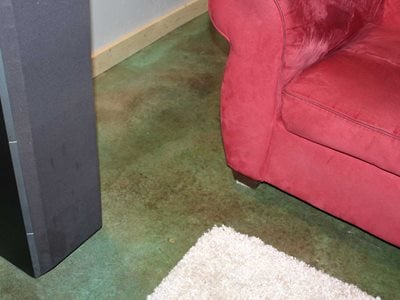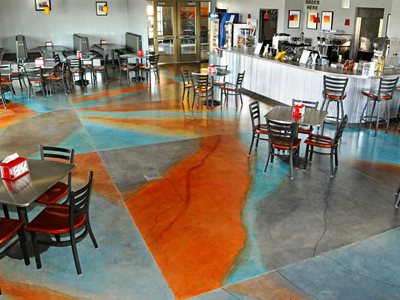Booth S11215
Concrete stains are an excellent way to color existing concrete. Using the right color concrete stain creates beautiful accents, highlights, and continuous color. The stained concrete pros and cons are determined by the kind of stain and the application.

Acid stains are among the oldest decorative concrete products on the market. They work by chemically reacting with the calcium compounds in the concrete. The acids and metallic salts permanently change the color in the upper portions of the concrete slab. This means two things for acid stained projects. First, the color is very durable and resistant to wear and fading. As long as the affected cement compounds are still there, the color will remain. Second, every installation is unique. Color is dependent on chemical reactions. Since no two slabs of concrete are exactly the same, every one will have unique variations in color intensity and mottling.
Acid stains have several distinct advantages. From a practical standpoint, the color is very durable and long lasting. Acid stains are also very well known in the marketplace, meaning they have consistent demand with potential customers and should be easy to sell. Acid staining contractors also have the advantage of being able to sell a totally unique product, as no two customers will every get the exact same floor.
Unfortunately, this variability can be a negative aspect for acid stains. Acid stains are more challenging to control and can be difficult to predict. Contractors will have to work harder to control their customers' expectations and be ready to accommodate unforeseen challenges. The acid stain installation process leaves little room for error, too. Any finishing inconsistencies, surface contamination, surface preparation inconsistencies, or spilled stain could easily be visible in the finished product. Contractors must also take great effort to make sure all of the stain residue is removed before applying sealer, otherwise the sealer will certainly fail.

Water-based stained concrete pros and cons are different from other products like acid stains. This makes them a good alternative in some cases. Water-based stains are composed of inorganic pigments with polymers suspended in water. The mixture is applied to concrete. As the water absorbs, the pigments are trapped in the pores of the concrete and bonded to it with the polymer. This creates translucent color at the very surface of the concrete.
Among the water-based stains pros and cons, the biggest plus sides are related to ease of use. Water-based stains are non-reactive, so they are very safe and easy to handle and apply. This also means the color development is more predictable than acid stains. Water-based stains can also be applied in a wide range of methods including sprayers, sponges, and brushes. Finally, water-based stains can be diluted and mixed to create totally unique colors and shades.
Lack of innate durability is a big drawback for water-based stains. Because the color is created by pigment settled in the pores of concrete, it is subject to fading. While the pigments are UV-stable, they can wash out over time with exposure to water. That is why, when coloring concrete patio with water-based stains, for example, the stained concrete should be sealed. The sealer protection must be maintained otherwise there is a risk of degrading the color. Water-based stains also require more skill to get a properly mottled finish. Acid stains, for example, will naturally marble and mottle but water-based stains require the applicator to purposefully make every variation.

If a contractor wants to polish a concrete floor, concrete dyes are probably going to be their choice. Dyes should be included in the stained concrete pros and cons because dyes work similarly and are used in some of the same situations. Dyes are made from super fine pigment particles. These come in straight powder or suspended in a small amount of liquid. The dye is then mixed with acetone or water and sprayed on the concrete surface where it rapidly absorbs. When mixed with acetone, dyes will yield stronger tinting and faster dry times.
Like water-based stains, dyes are easier to use and more predictable than acid stains. Dyes absorb rapidly with minimal residue, making them great for fast turnaround construction. This rapid absorption also makes dyes a great option for touch up and stenciling work. They are less likely to migrate and bleed, making it possible to achieve crisp, dyed lines in patterns and stencils. Because dyes are often available in colors corresponding with acid stains, dyes are also a great tool for filling in and correcting areas where acid stain does not react with the concrete.
The biggest limitation with dyes is a lack of UV-stability. If exposed to direct sunlight, dyes will eventually fade or turn black. This means they are not suitable for outdoor or exterior uses. Dyes are generally limited to basements, interior retail spaces, and other applications protected from UV-light. When mixed with acetone, dyes also require significant safety precautions be taken to reduce the risks associated with volatile fumes in confined spaces. This can include turning off pilot lights, using non-sparking tools, and improving ventilation. Mixing dyes with water will remove these risks at the expense of color vibrancy and rapid drying.
When comparing stained concrete pros and cons, non-stain options should also be considered. Some of these products share stained concrete pros and cons, but they may bring in some other qualities that could be better or worse for an application. For example, when placing new concrete, an integral color or color hardener will produce more consistent, stronger coloration. When used in conjunction, these materials can also reproduce patterned and mottled effects to some degree. Likewise, various overlays and cementitious coatings will create more solid, durable color on existing concrete. While these are all viable coloring options for concrete, none of them will truly match what a stain or dye can do. Brickform does offer some nontraditional stain alternatives for recoloring and restoration such as Tinta' Seal and Refresh.
Explore impressive concrete installations to find inspiration for your next project.
Find out how much color and fiber you'll need for any size project.